| dispersion and spectral resolution |
|
Two of the most important properties of a spectrograph are the dispersion, which sets the wavelength range of the spectrum, and the spectral resolution, which sets the size of the smallest spectral features that can be studied in the spectrum.
dispersion
It is generally more convenient to express dispersion in terms of a
linear scale at the detector rather than an angle. Hence, linear
dispersion is defined as the rate of change of the linear
distance, x, along the spectrum with wavelength:
dx / dλ = (dx / d![]() )
(d
)
(d![]() / dλ) = Fcam
(d
/ dλ) = Fcam
(d![]() / dλ),
/ dλ),
where Fcam is the focal length of the spectrograph
camera, which is equal to the inverse of the plate
scale, p = d![]() /
dx. This equation is often inverted to give the
reciprocal linear dispersion, i.e. the wavelength range for a
particular length at the detector:
/
dx. This equation is often inverted to give the
reciprocal linear dispersion, i.e. the wavelength range for a
particular length at the detector:
dλ / dx = d cos ![]() / n Fcam.
/ n Fcam.
Note that the reciprocal linear dispersion is a length divided by a
length, and this can lead to confusion with units. Generally, the
reciprocal linear dispersion is expressed in units of nm/mm or
Å/mm. For example, if a spectrograph has a linear dispersion of
10 Å/mm and the CCD detector being used has a size of 20 mm in
the dispersion direction, then the wavelength range of the
resulting spectrum will be 200 Å.
spectral resolution
The spectral resolution or spectral resolving
power, R, of a spectrograph is defined as the ability to
distinguish between two wavelengths separated by a small amount
Δλ. Spectral resolution is usually quoted either in terms
of Δλ (usually in units of nm or Å) or in terms of
the dimensionless quantity:
R = λ / Δλ.
As a rough guide, spectrographs with R < 1000 are regarded as
low resolution and they generally do not allow the spectral
lines from astronomical sources to be resolved. Spectrographs with
1000 < R < 10,000 are regarded as intermediate
resolution, and these do enable the study of the broadest
spectral lines. However, only high-resolution spectrographs,
with R > 10,000, enable the narrow spectral lines emitted by
most stars to be studied in detail. Note that, in comparison,
broad-band photometry has an effective spectral resolution of
R ~ 5. Examples of low- and intermediate-resolution spectra of
the same star are shown in figure 93.
| figure 93: |
Low resolution (left) and intermediate resolution (right) spectra of
the cataclysmic variable star V1315 Aql.
|

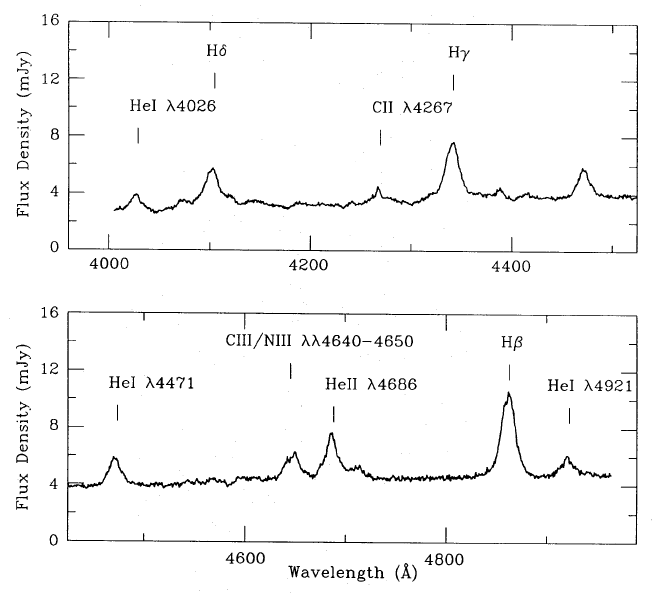
The inverse of the spectral resolution is equal to the expression
describing the non-relativistic Doppler shift:
1 / R = Δλ / λ = v / c,
where v is the radial velocity of the source and c is
the speed of light. Hence a spectral resolution of R = 10,000
would enable a wavelength shift of Δλ = 0.0001 x λ to
be measured, which implies that only Doppler shifts larger than
v = 0.0001c = 30 km/s could be measured. The above formula
also implies that it is possible to plot spectra on both wavelength and
velocity scales, as shown in figure 94.
| figure 94: |
Spectra of the Hβ emission line in the
cataclysmic variable star SW Sex, plotted on a wavelength
scale (left) and a velocity scale (right).
|
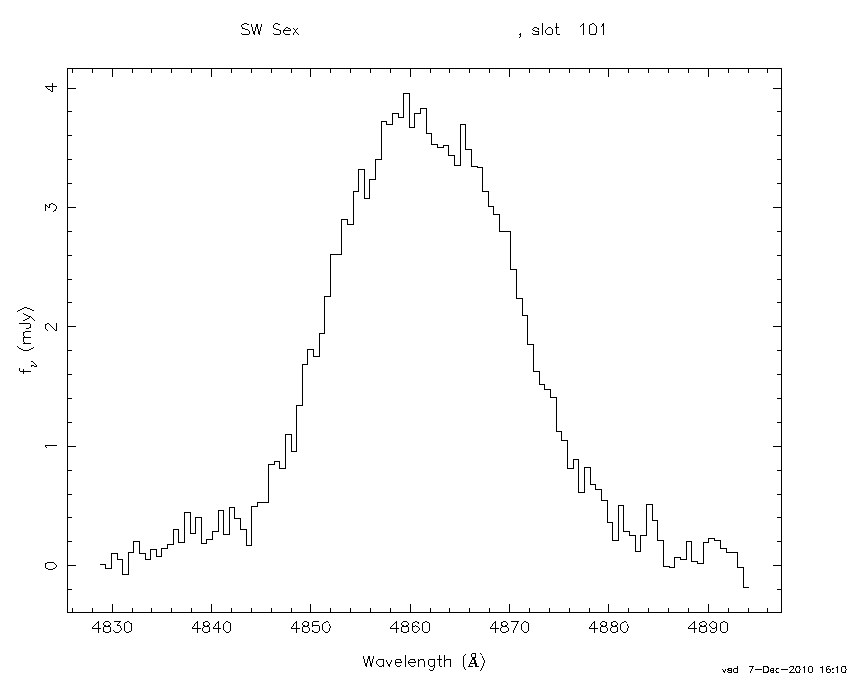
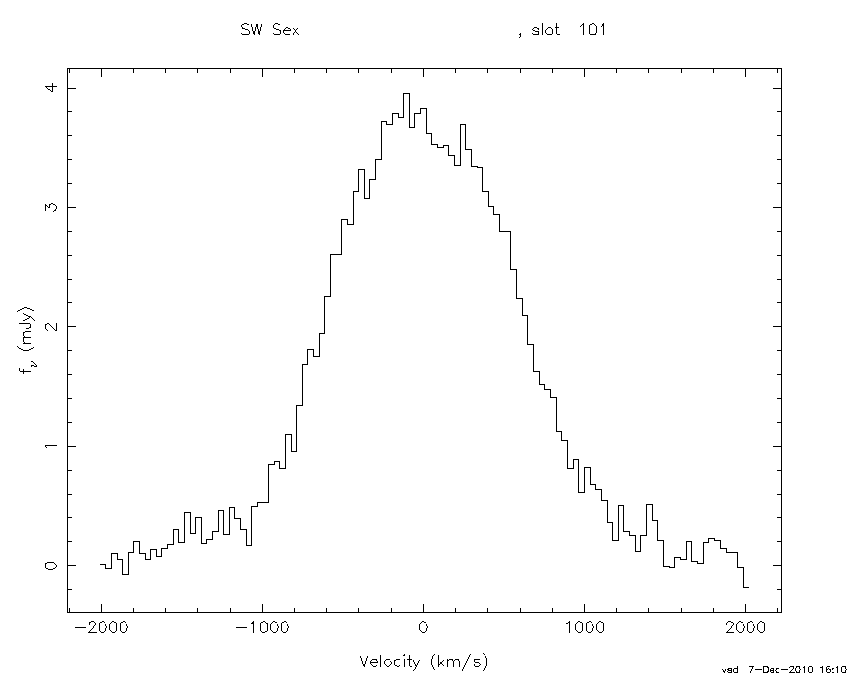
In a similar way that there is a limit to the spatial
resolving power of a telescope, there is a limit to the
spectral resolving power of a spectrograph. Diffraction by
the grooves in the grating form a diffraction pattern, as shown in the
upper panel of figure
89, which in cross section would look similar to that shown in the
right-hand panel of figure 4.
Adopting Rayleigh's
criterion, two spectral lines would be said to be just resolved
when the maximum of the diffraction pattern of one line falls on the
first minimum of the diffraction pattern of the other. The
diffraction-limited spectral resolution (or simply
limiting resolution) of a spectrograph is then given by,
R = Nn,
where N is the total number of lines used across the
grating. It can be seen that a higher spectral resolution can be
obtained by increasing the order of the spectrum or increasing the
total number of rulings in a grating, which for a fixed-sized grating
implies increasing the ruling frequency. For example, a grating may
have 300 lines/mm, in which case a 20 mm diameter grating used in
first order would have a diffraction-limited spectral resolution of
R = Nn = 300 x 20 x 1 = 6,000, but working in the second
order with a 600 lines/mm grating would give R = Nn = 600 x
20 x 2 = 24,000, i.e. four times the spectral resolution.
In reality, however, in the same way that the spatial resolution of a telescope is limited by the seeing, pixel size and/or quality of the telescope optics, not by diffraction, the spectral resolution of a spectrograph is limited by the slit width, detector sampling and/or spectrograph optics, not by diffraction, as discussed below:
| figure 95: |
Image of a star observed through a 5" wide slit (left) and a 1.5" slit
(right) with ULTRASPEC.
|
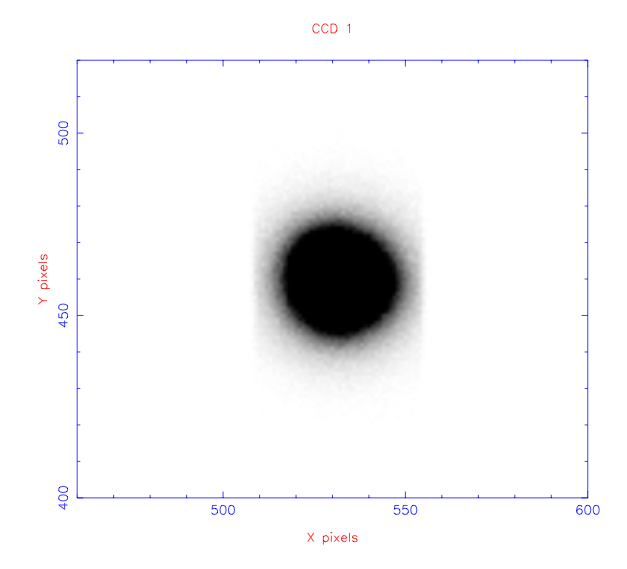
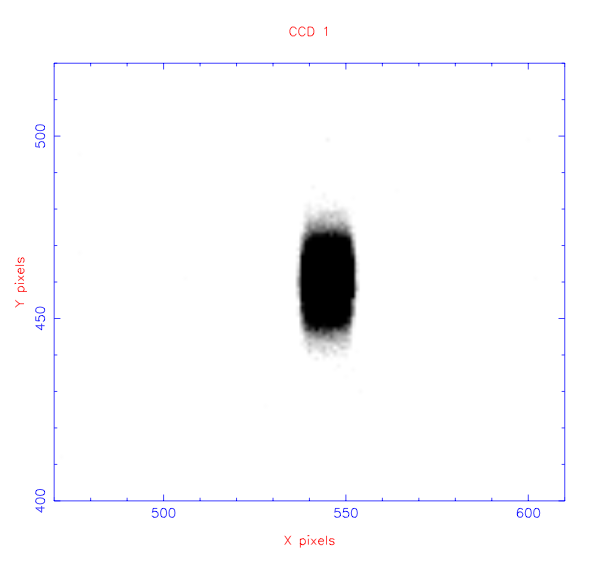
It is important not to confuse dispersion and spectral resolution. If the reciprocal linear dispersion is 1 Å/pixel, this does not mean that the spectral resolution is Δλ = 1 Å. As discussed above, most well-designed spectrographs will have a slit width in the telescope focal plane that is approximately equal to the seeing, and this slit width will project to two pixels on the CCD detector. In this case, the spectral resolution would be 2 Å, i.e. the spectral resolution is generally twice the reciprocal linear dispersion. Some example calculations involving the concepts of dispersion and resolution are given in the example problems.